Lakes are bodies of water that are mostly surrounded by land. While lakes may not look like much, they are home to a diverse group of animals that play essential roles in the ecosystem.
Here are fifty-one animals that you can find in, on, or around lakes:
Table of Contents
1. Axolotl (Ambystoma mexicanum)
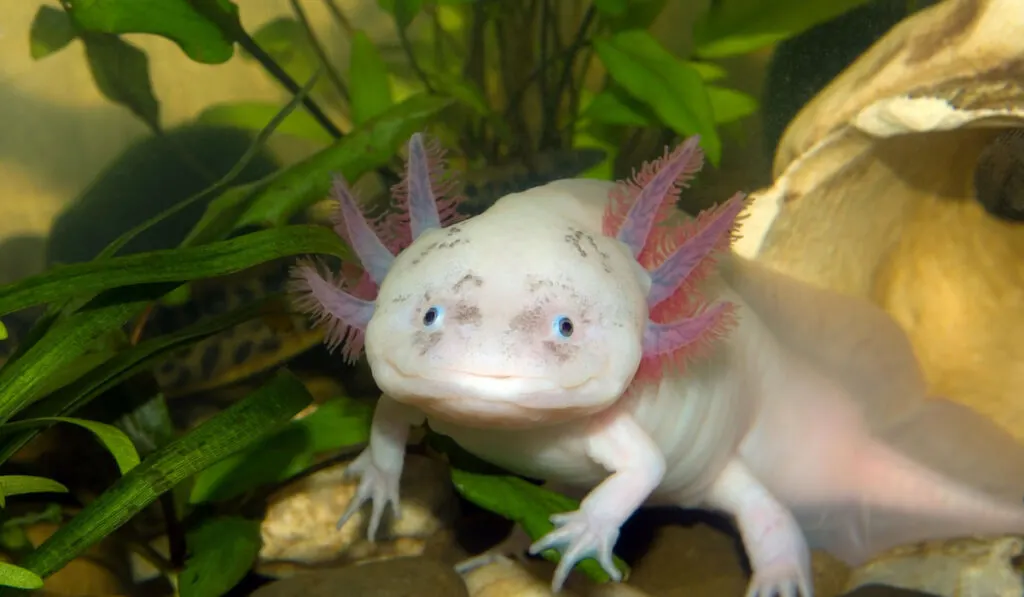
Axolotls are beautiful aquatic salamanders. Unlike other salamanders, this species remains in the water and retains its gills in adulthood.
Axolotls look as cute as their gills. Axolotls are omnivores but prefer to eat invertebrates and other smaller animals.
These salamanders are popular in pet markets, but they are endangered in the wild.
2. Muscovy Duck (Cairina moschata)
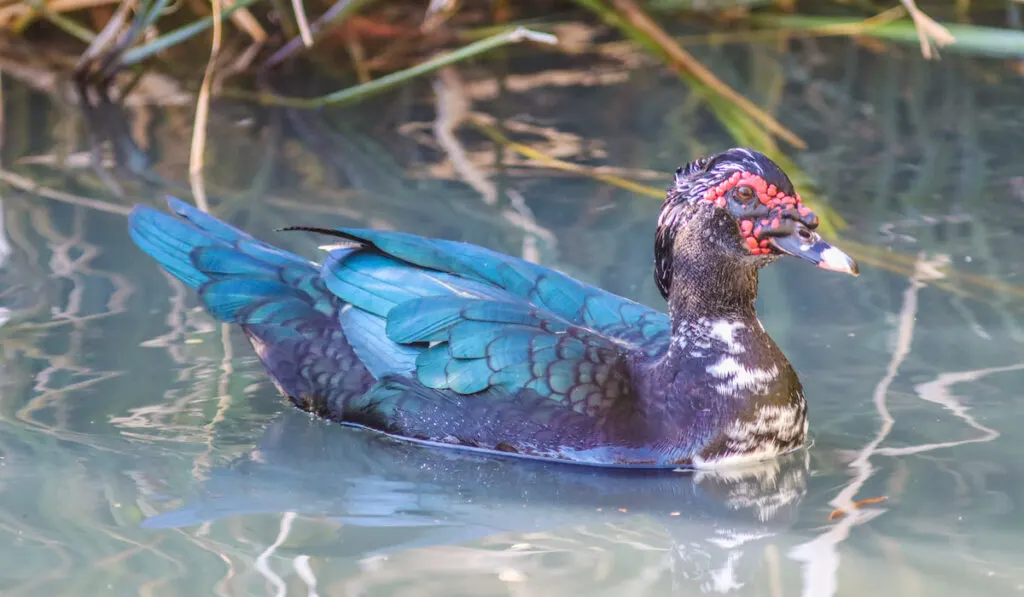
Muscovy ducks are found in the Americas. Like other types of ducks, these ducks spend much of their time in, on, or around lakes.
They can be white, black, green, or blue-green and eat anything that they can find, including insects, spiders, fish, and other smaller animals.
Muscovy ducks make great swimmers. If you want to raise them, ensure they have a place to swim.
3. Long-Tailed Duck (Clangula hyemalis)
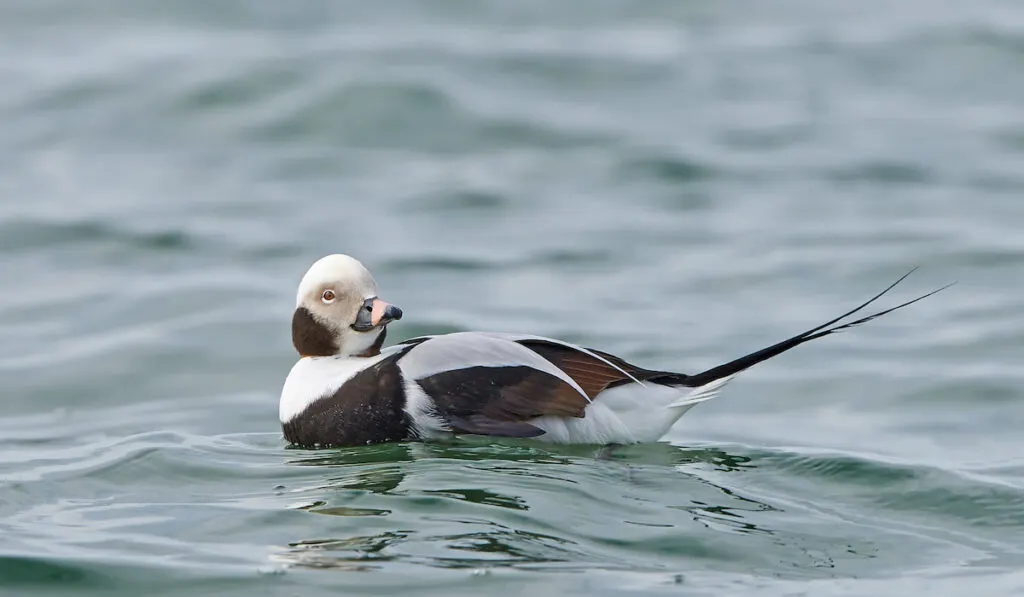
Long-tailed ducks are cute, white and black (or brown) ducks with long tails and short beaks.
They enjoy swimming in lakes and eating a lot of fish as well as other animals that they can find in the water.
When it is time to mate and lay eggs, long-tailed ducks leave the water and live on land until their ducklings are ready to swim.
4. Snapping Turtle (Chelydra serpentina)
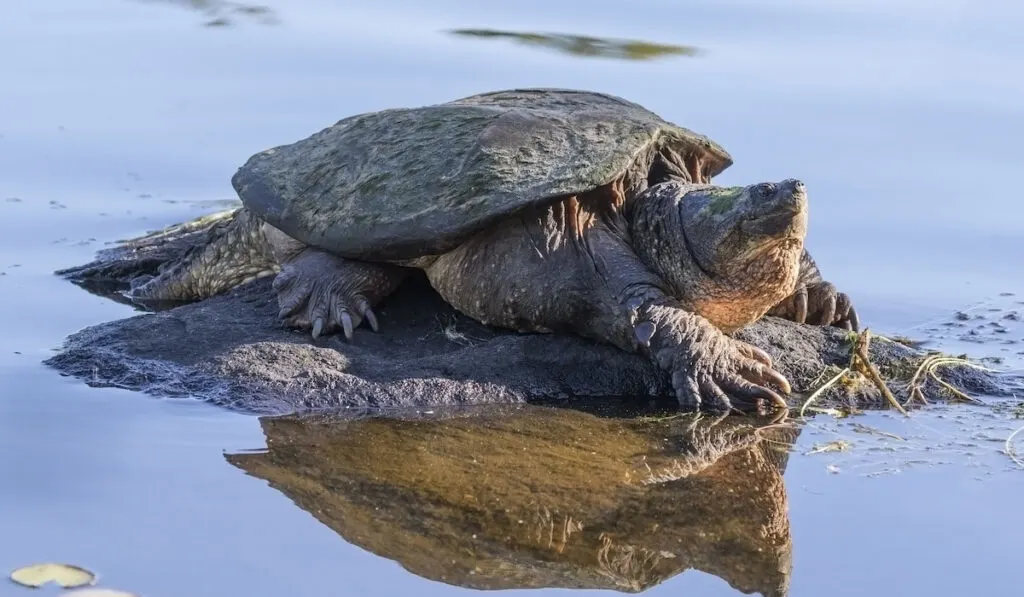
Snapping turtles are highly-adaptive turtles that you can find in almost every type of water body so long as the water is not polluted.
They have a strong jaw that they can use while eating hard prey. These turtles can eat insects, plants, worms, spiders, frogs, fish, snakes, small turtles, crayfish, birds, and small mammals.
While they spend much of their time swimming in the lake, they will sometimes come onto land.
5. Deepwater Sculpin (Myoxocephalus thompsonii)
Deepwater sculpins are fish that you can find in the cold lakes of the United States and Canada. They live in both fresh and salt waters.
This species has been around since the Ice Age and can be found deep underwater.
Deepwater sculpins eat whatever they can find. Their diet includes plankton, other smaller fish, shrimp, etc.
6. Cricket (Grylloidea family)
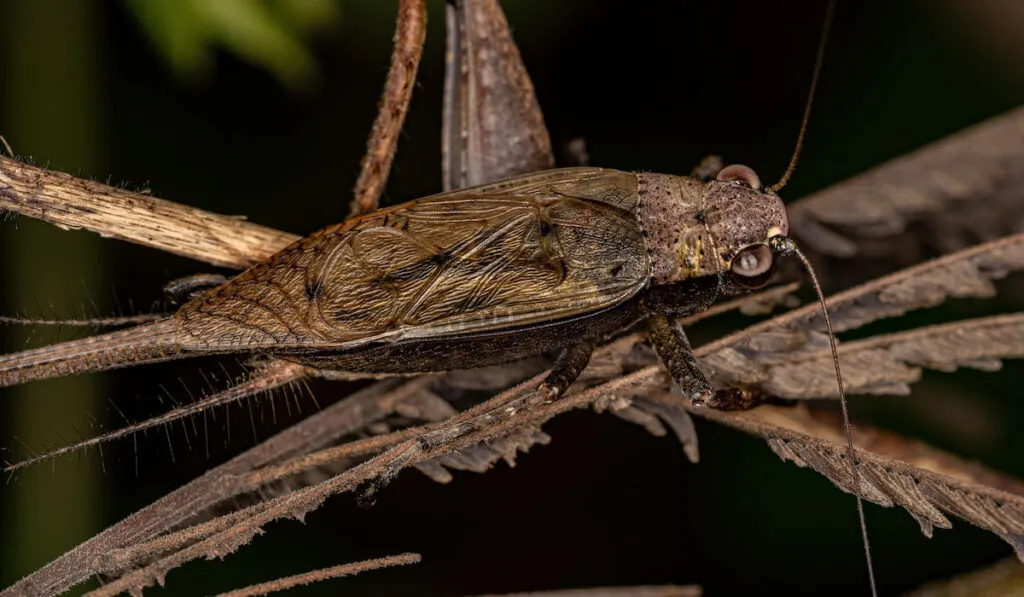
“Cricket” refers to insects in the Grylloidea family. They are characterized by the sound that they make, especially at night.
These insects can live both on land and water, but they prefer to live around water as their food usually grows in abundance around water bodies.
Crickets eat aphids, insect larvae, flowers, leaves, seeds, grasses, and fruit.
7. Bass (Micropterus salmoides)
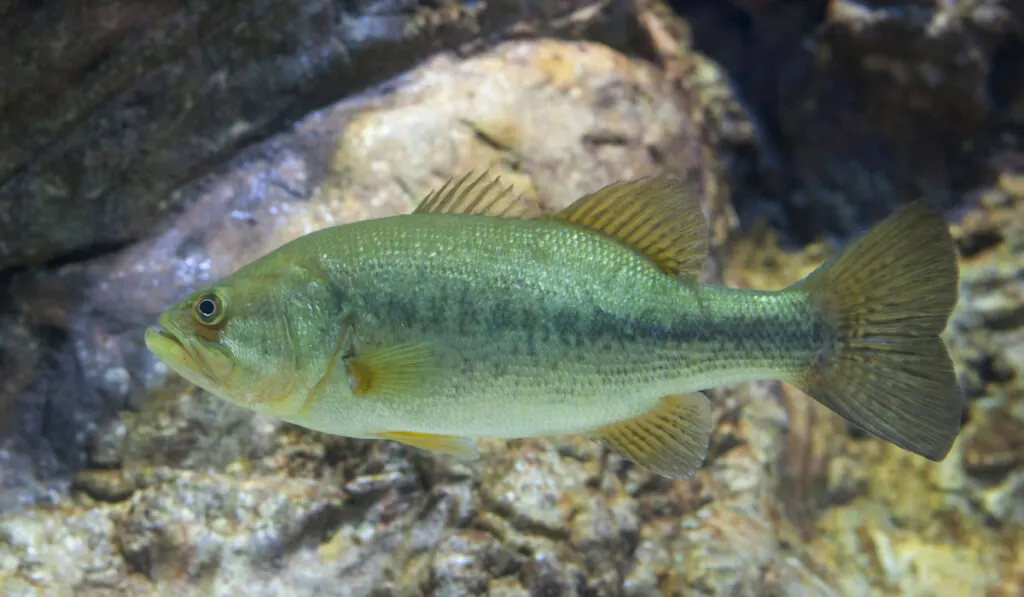
Bass is a carnivorous fish that naturally lives on the North American continent. However, it has been introduced in other places, as it can be used to control the population of fish.
Bass eat other fish, so if a lake is filled with invasive fish species, people introduce bass into the lake to control the population of the invasive species.
8. Flamingo (Phoenicopterus roseus)
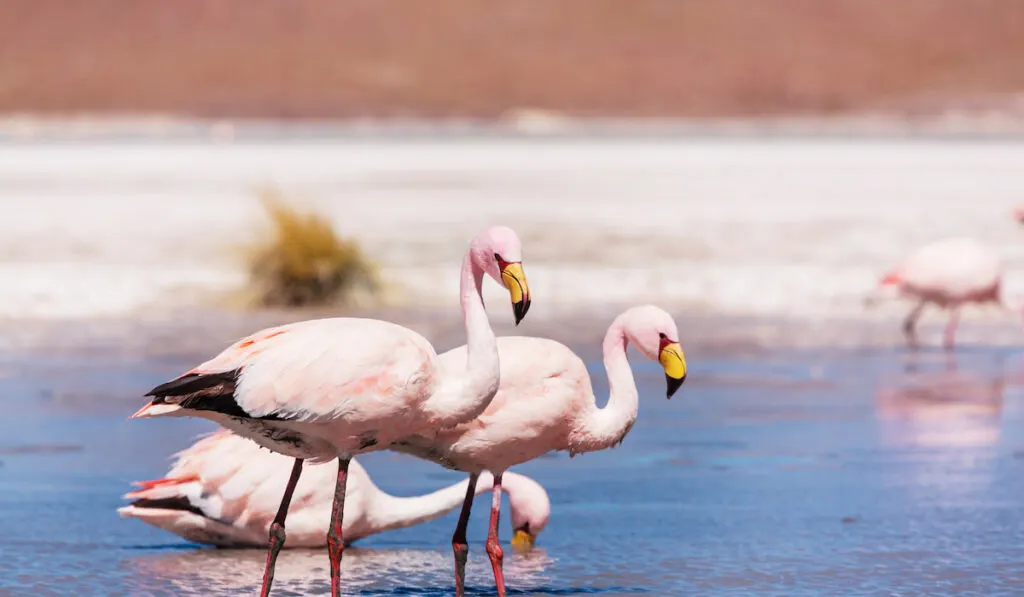
Flamingoes are beautiful pink birds. These birds are originally white but become pink due to their diet of shrimp.
Flamingoes fly and usually live around many types of water bodies, especially lakes. They eat shrimp and other invertebrates from the lakes but sleep out of the water.
These beautiful birds have very long legs and necks that allow them to move and eat freely in or around lakes.
9. Opossum Shrimp (Mysida)
Opossum shrimp are crustaceans resembling shrimp but with a unique feature. The females of these shrimp-like animals have a marsupium or brood pouch where they nurse their young.
Opossum shrimp nurse their young instead of releasing them in the water.
They can be found in so many freshwater bodies in the world, especially lakes.
10. Walleye (Sander vitreus)
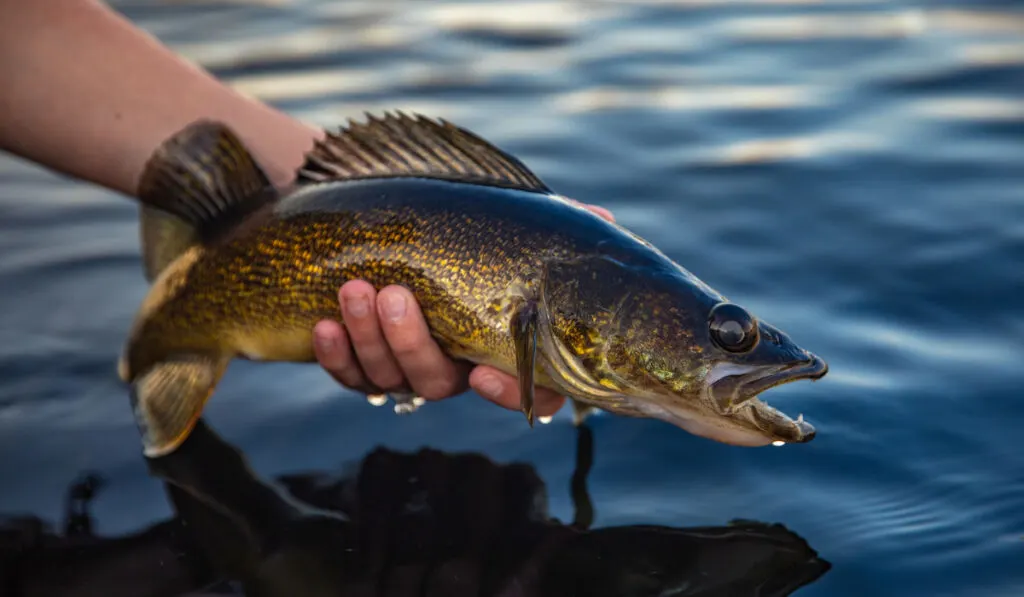
Walleyes are beautiful fish found in lakes and other water bodies in the United States. While the adults eat other fish, young walleyes eat smaller animals, such as crustaceans and plankton.
Other names for the walleye fish include yellow pickerel or yellow pike. They have some beautiful gold-colored scales and fins.
11. Great Diving Beetle (Dytiscus Spp.)
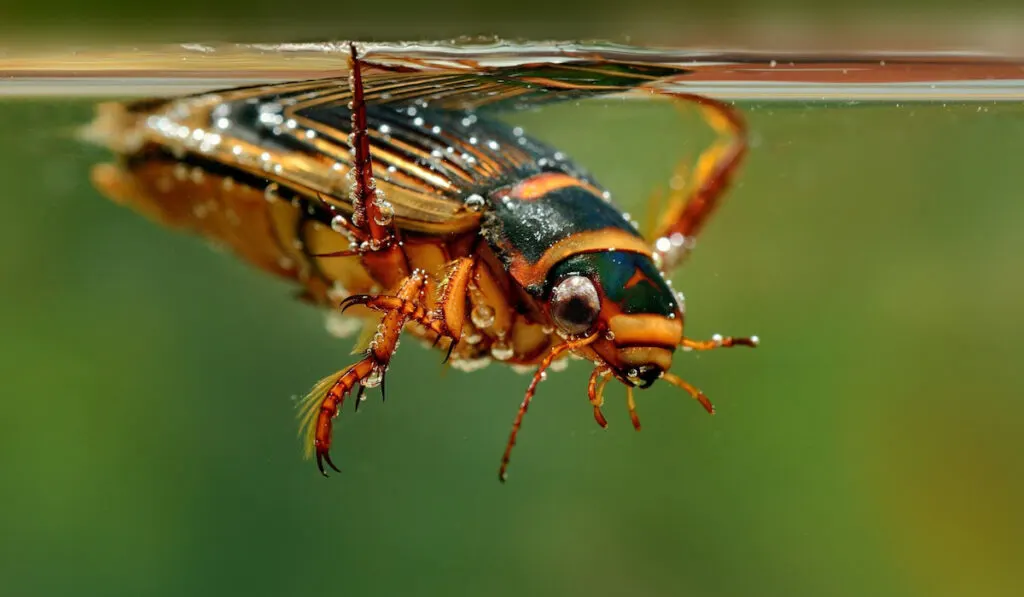
These are aquatic insects that look for fish larvae and other smaller animals to eat. They mostly live in water bodies but can sometimes be found outside the water.
If you have a pond or any place with little fish, you must watch out for these insects as they are not fish-friendly. However, they are prey for a lot of carnivorous fish.
12. Beaver (Castor spp.)
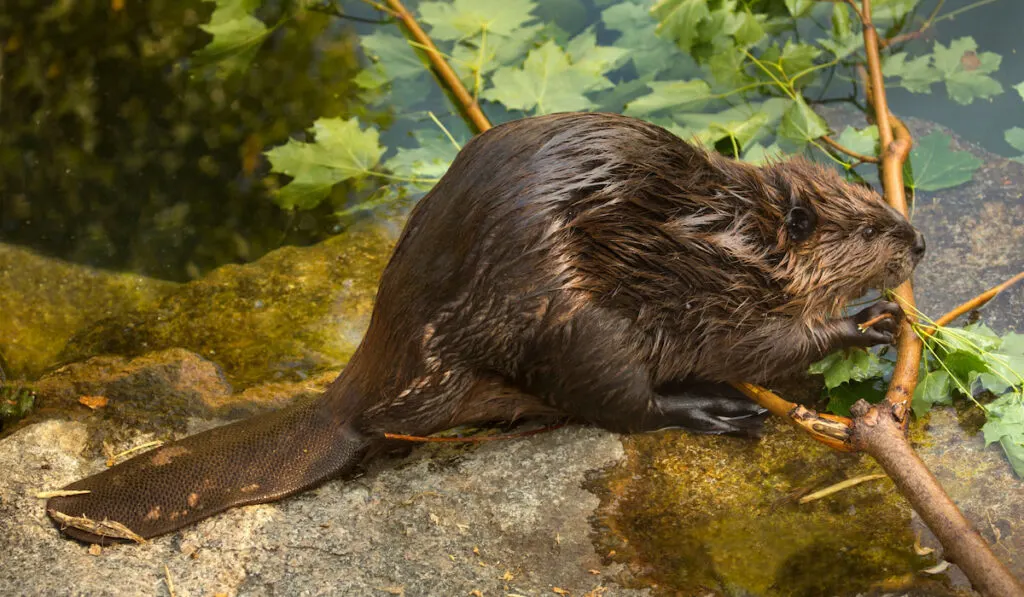
Beavers are mammals with flat tails that are very popular because of their role in the ecosystem of lakes. While beavers are found in many types of water bodies, they are common in lakes where they also build dams.
Beavers collect sticks and twigs, using them to reduce the water current so that they can live in slow-moving waters.
Beavers eat plant products such as leaves, flowers, and seeds. They are prey to larger animals, especially mammals.
13. Frog (Anura)
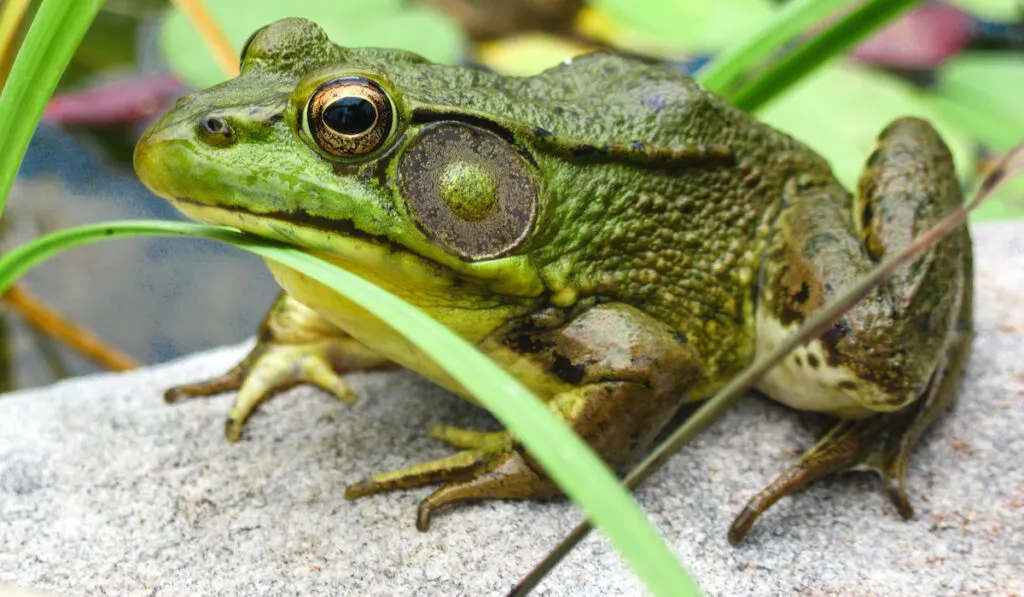
Frogs are amphibians that spend all of their lifecycle in or very close to water bodies, especially lakes and other slow-moving waters. Frogs hatch from their eggs as tadpoles and later transform to become the adults that we know as frogs.
While toads also lay their eggs in water, toads tend to travel far from the water body when they are matured, unlike frogs.
14. Otter (Lutrinae)
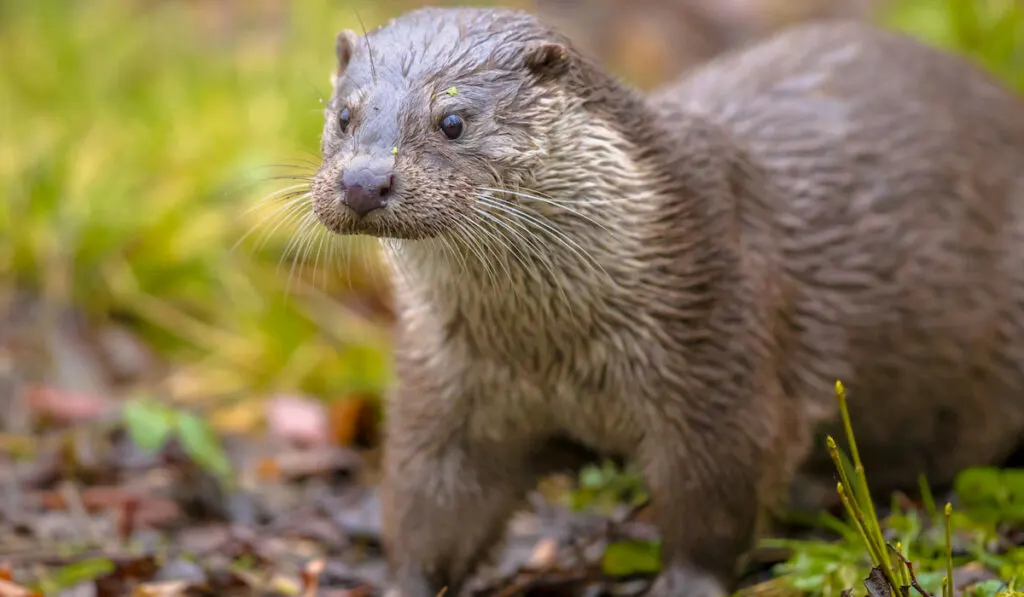
Otters are mammals that are closely related to animals such as mink, weasels, badgers, and wolverines. They mostly live around water bodies and even float on water when they are idle.
Otters are carnivorous, eating fish, crustaceans, and anything that can move in the water. While they can be found in lakes, you can also find them in rivers and oceans.
15. Lake Whitefish (Coregonus clupeaformis)
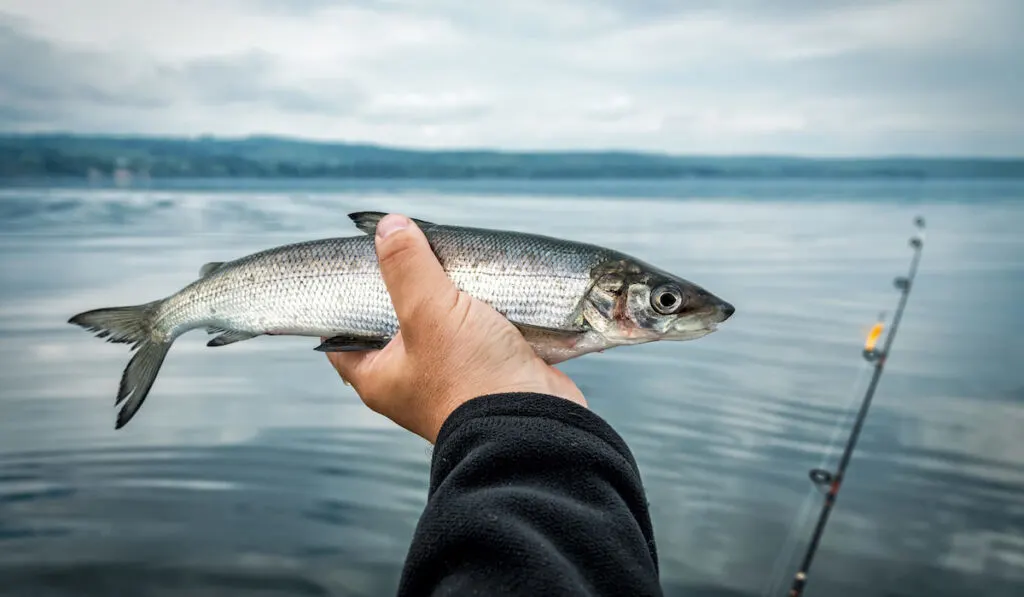
As their name suggests, lake whitefish are types of white fish that live in lakes. These beautiful fish are white or have some white scales that give them a reflective look.
They are mostly found in Canadian and American lakes, though they have been introduced in other places.
These fish have an omnivorous diet but mostly eat crustaceans.
16. Dragonfly (Anisoptera)
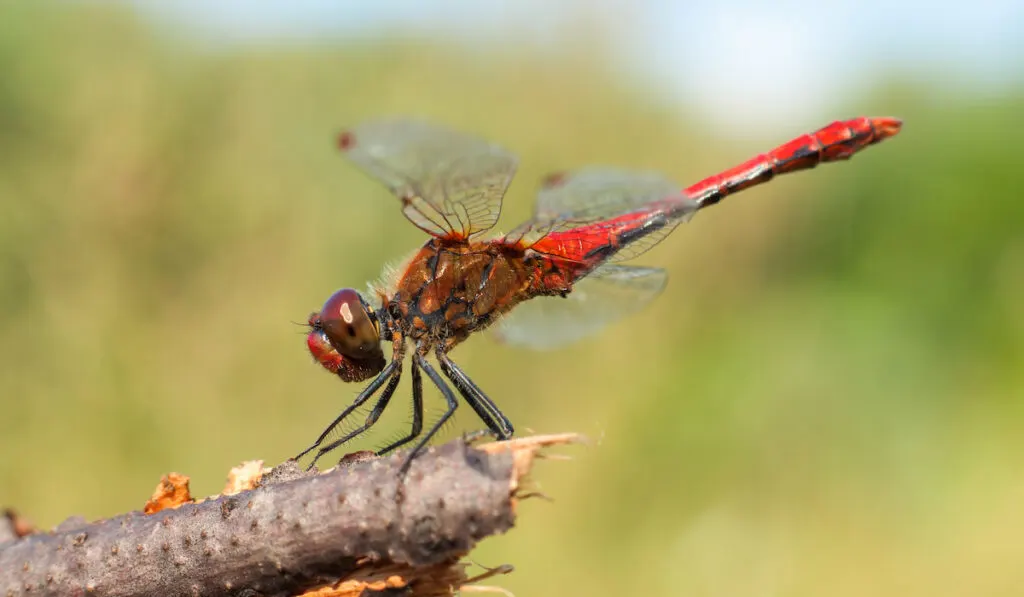
Dragonflies are predatory insects that spend some parts of their lifecycle in water and other parts flying around a water body.
While they are found in so many types of water bodies, they prefer the slow-flowing ones such as lakes.
Did you know that with a success rate of around 9%, dragonflies are the most successful predators in the world? They owe their success rate to their good eyesight and body coordination.
17. Diving Bell Spider (Argyroneta aquatica)

Diving bell spiders are aquatic spiders that live in or around lakes. They search for and eat fish larvae, zooplankton, etc. They are also prey to a lot of fish.
Did you know that many water spiders can walk on water?
They have hairs on their light feet so they can move freely without breaking the water’s surface tension.
18. Caddisfly (Trichoptera)
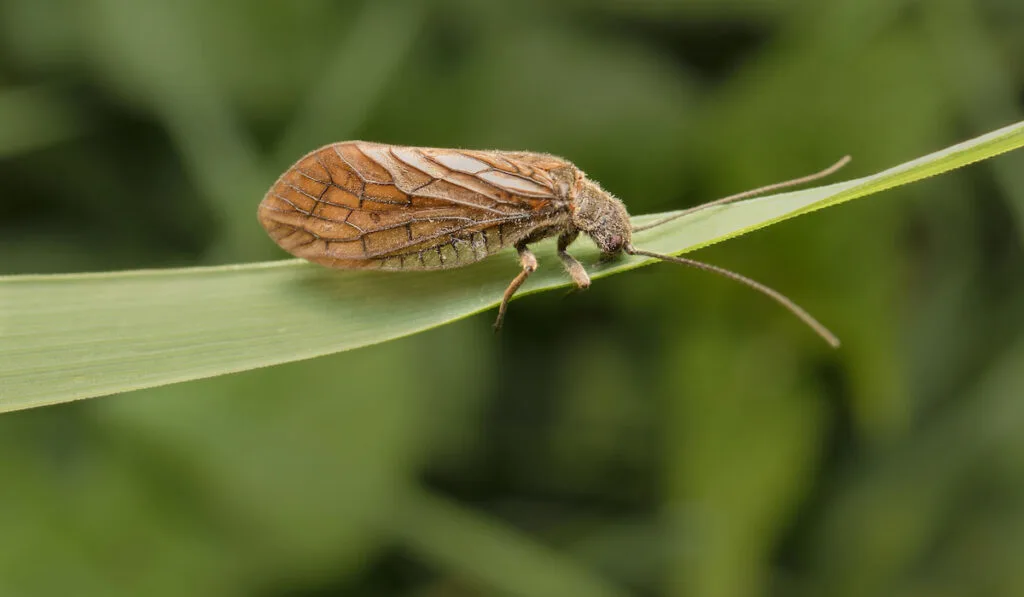
Caddisflies are insects. When they are larvae, they can live in lakes and other types of water bodies.
As adults, they will return to the water when it is time to mate and lay eggs.
Caddisflies have very long and beautiful wings and very long antennae. Their larvae have long abdomens.
19. Golden Carp (Probarbus jullieni)
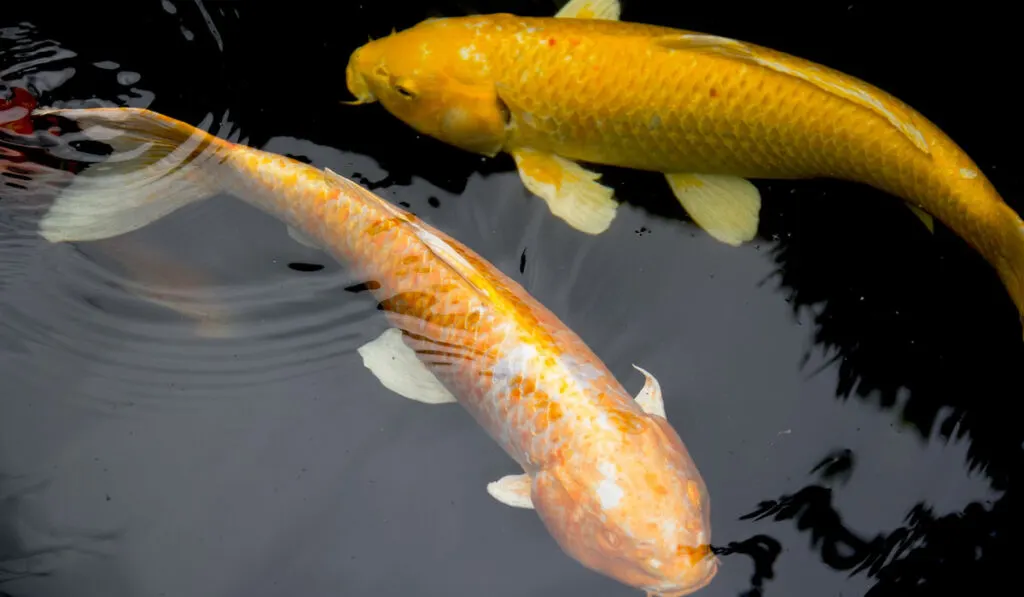
Golden carp is an endangered ray-finned fish with gold and black-colored scales. These carp usually eat other smaller fish, plankton, and insects in the lake or whatever water body they live in.
Carp originate from Asia and have been suffering from a decline in their natural habitat due to unsustainable fishing. There are very few wild carp, while there are many kept as pets or in aquaculture.
20. Painted Turtle (Chrysemys picta)
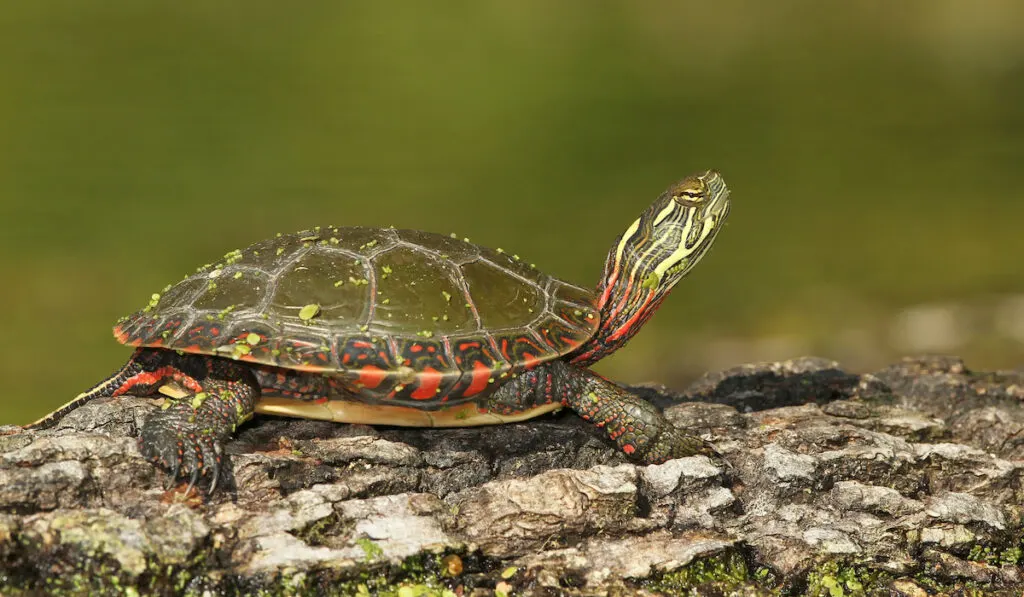
This is the most widespread type of freshwater turtle in North America.
Painted turtles prefer to live in wetlands with long periods of flooding. However, you can also find them in lakes and other types of freshwater bodies.
They have an omnivorous diet and eat whatever they can find, including plant and animal products.
21. Zebra Mussel (Dreissena polymorpha)
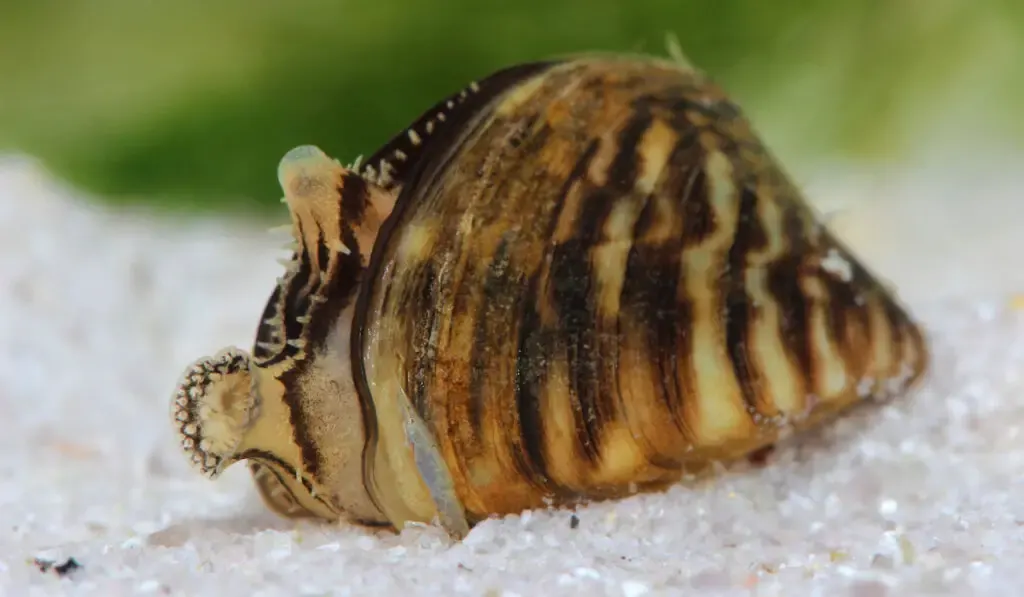
This is a freshwater mussel native to Ukraine and Russia but has now been introduced and naturalized in other places.
Like other clams, zebra mussels open their shells when they want to eat and wait for plankton and other types of food to float or swim into the shells. These mussels close their shells to catch their prey or hide from predators.
22. Water Boatman (Corixidae)
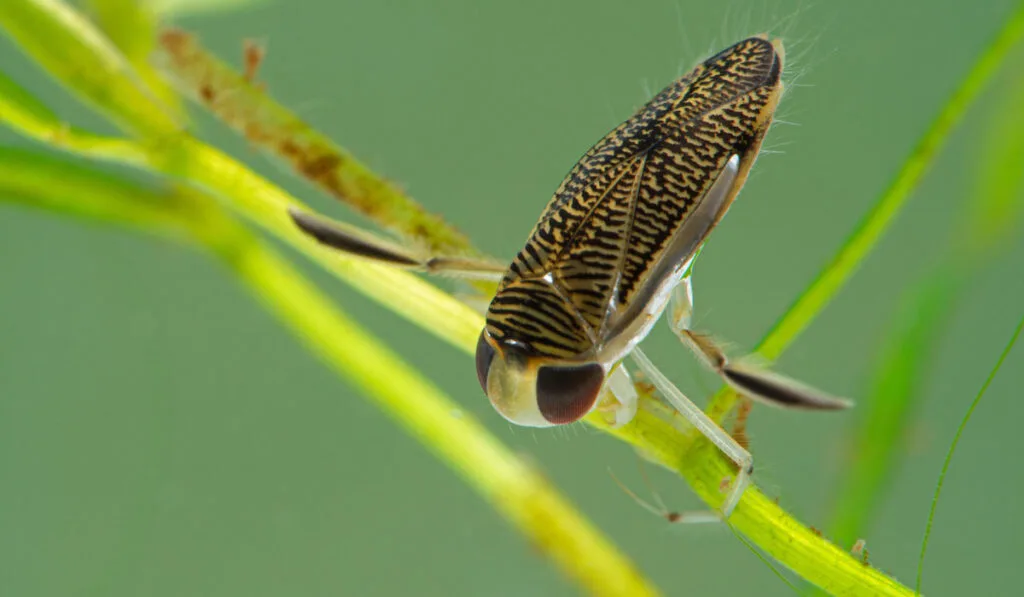
Water boatmen are aquatic insects that you’d love to see.
One unique trait of these insects is that they mostly swim backward, so even if you are in front of them, they do not have to turn around before escaping.
They mostly eat plankton and anything smaller than they are. Water boatmen are prey to almost every carnivorous fish in a lake.
23. Bluegill Fish (Lepomis macrochirus)
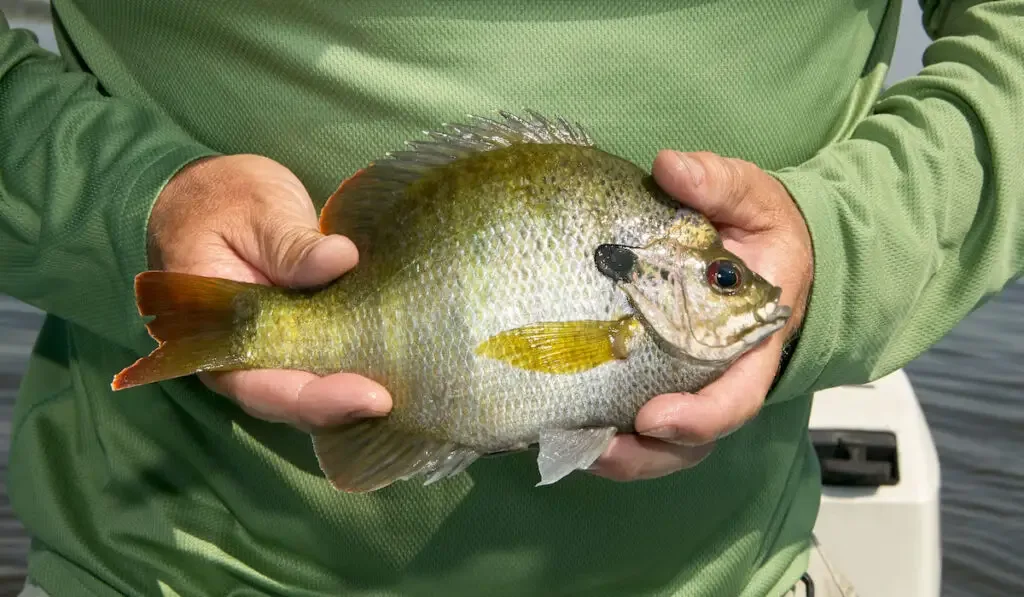
Bluegill are American freshwater fish that you can find in streams, lakes, rivers, and wetlands. Though they resemble tilapia fish, they are not tilapias and are easy to identify with their short blue gills.
The operculum of this fish (i.e., the covering of their gills) has a blue spot on its tip, so seeing the blue color can help you to identify the fish.
24. Muskrat (Ondatra zibethicus)
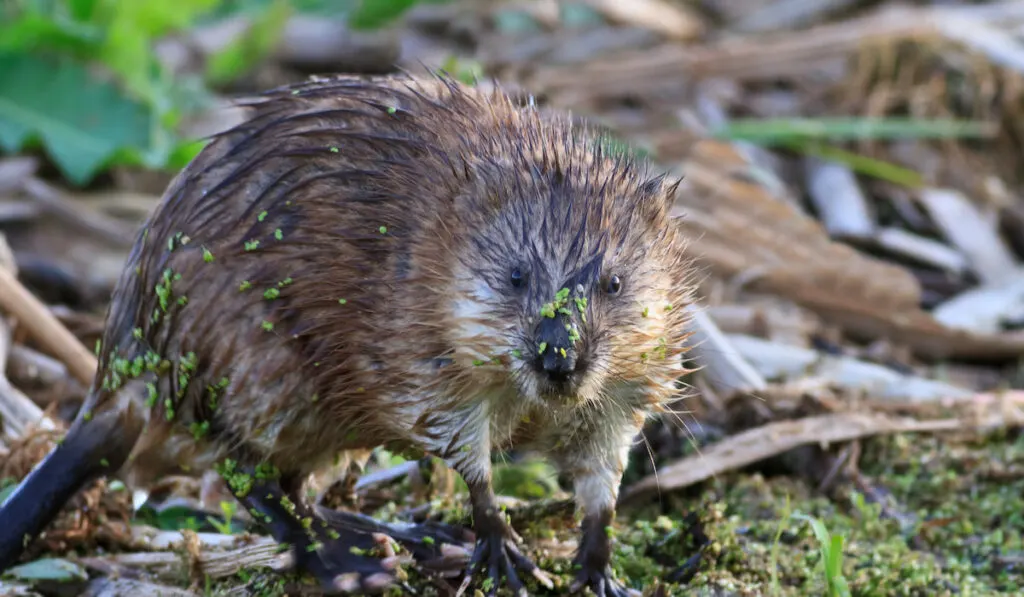
These are aquatic rodents play a vital role in ecosystems both in and out of lakes. They live most of their lives in or around water bodies but give birth on land.
People make use of muskrats as a source of food and fur. Their young are prey to aquatic animals such as large fish and alligators. These rodents eat whatever they can find in the lake.
25. Zooplankton
“Zooplankton” refers to various types of very small floating organisms. These animals may be macroscopic or microscopic, and they play a major role in the ecosystem of every water body.
Zooplankton may be free-floating in their entire lifecycle or in the larvae form of an animal.
Zooplankton eat phytoplankton (their plant counterparts) and are eaten by so many types of animals including young fish.
26. Catfish (Siluriformes)
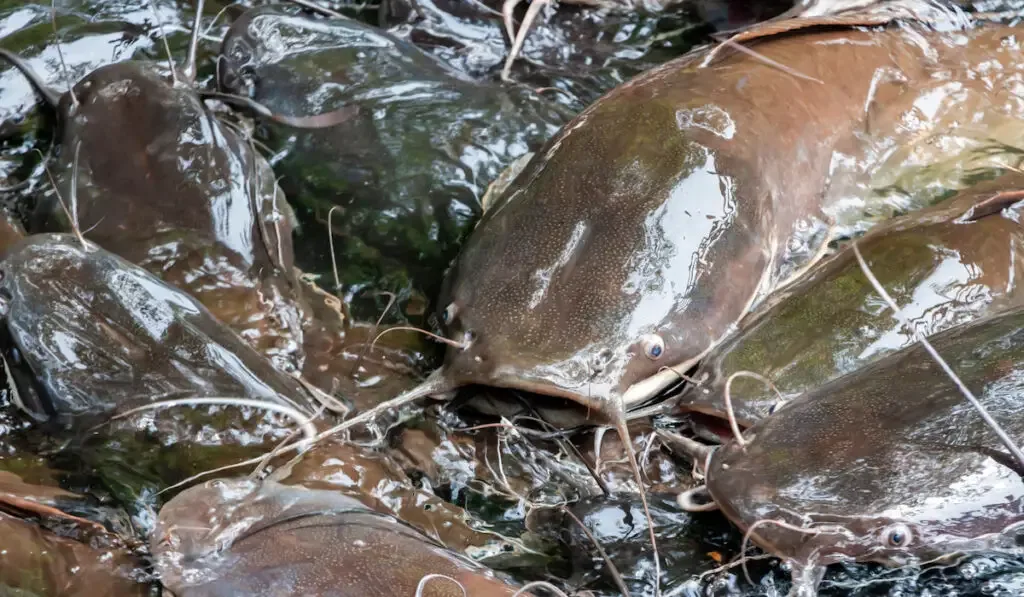
Catfish are beautiful fish known for their barbels (or whiskers). They are omnivores that prefer eating other animals, including fish and insects.
Catfish are mostly found in fresh waters, but some can live in estuaries.
Did you know that catfish can live outside lakes and other water bodies for a very long time?
Catfish will not die due to a lack of dissolved oxygen (i.e., oxygen in water). Instead, they will die due to the heat of the sun drying out the slime on their skin.
27. Lake Herring (Coregonus artedi)
Lake herring or ciscos are fish in the family Salmonidae. They are found in freshwater bodies just like rivers and lakes and are popular fish that make up our diet as humans.
These fish are omnivorous but mostly eat other animals, such as crustaceans and gastropods. You can find lake herring in the open waters of the Great Lakes.
28. Perch (Perca)
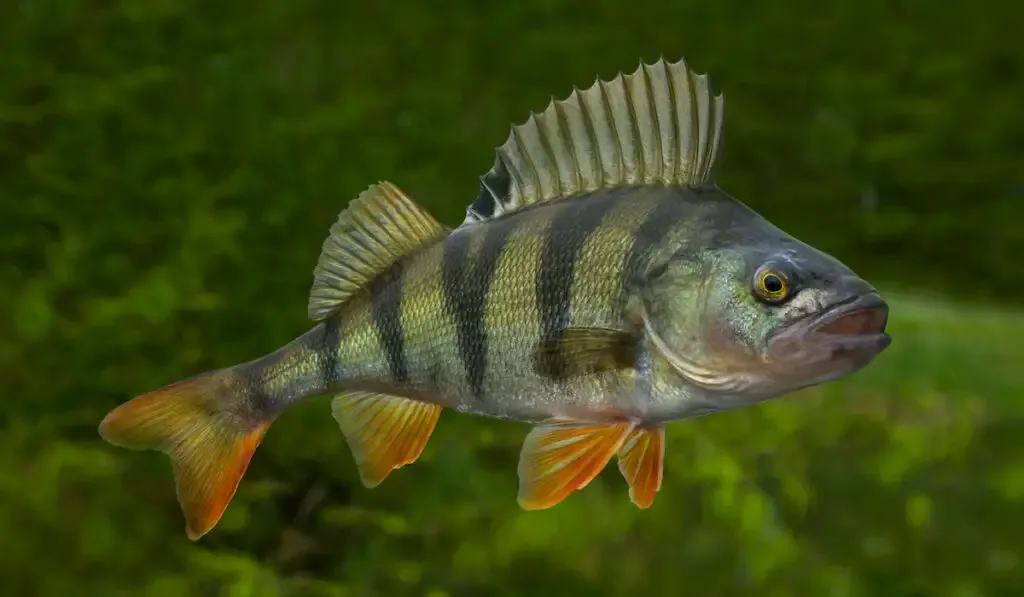
Perch are fish with bright-colored scales that are mostly yellow and black or other colors with a zebra pattern. They are freshwater fish that you can find in lakes, rivers, and streams.
29. Water Snake (Nerodia spp.)
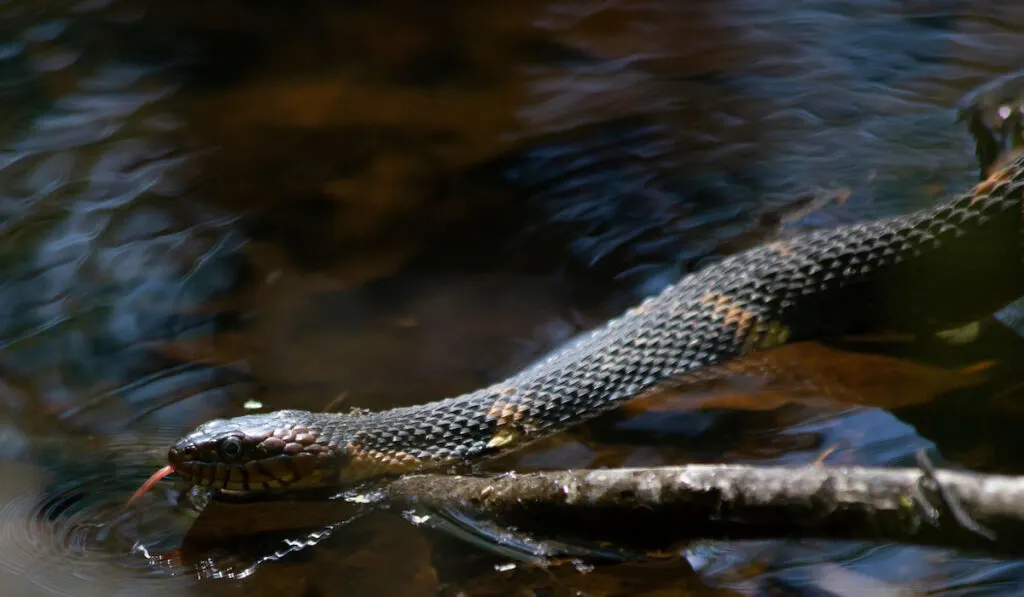
“Water snake” refers to any of the snake species that spend most of their lifecycle in water. They hunt for fish and other animals in the water and are sometimes eaten by larger fish and birds of prey.
30. Fiddler Crab (Uca spp.)
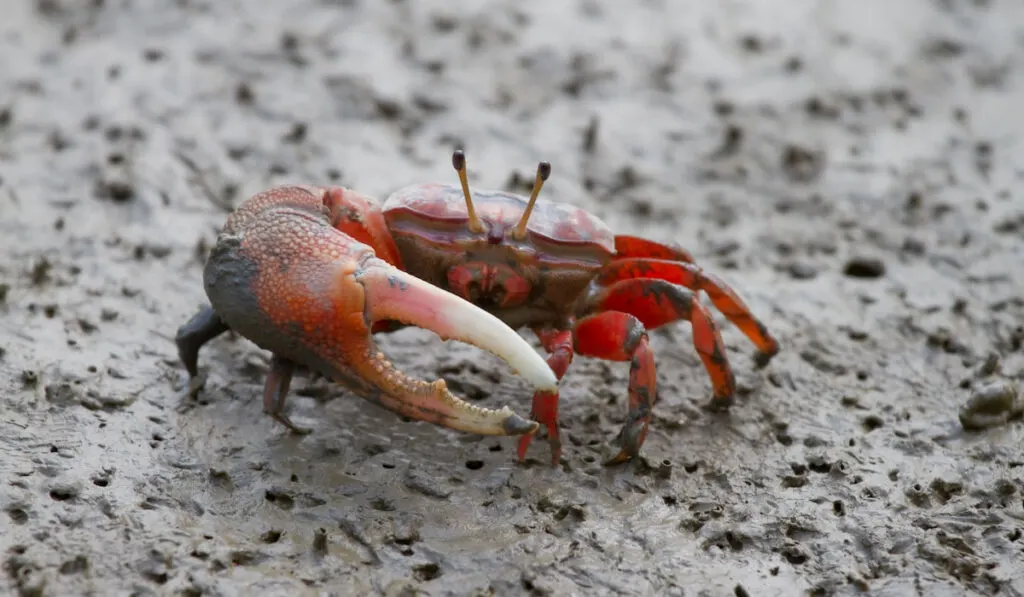
Fiddler crabs are characterized by the bright coloration of their large claws. There is a very noticeable and impressive difference between the size of the two laws, especially in males.
The males of this crab wave to the females with their large claws to attract them for mating.
31. Goose (Anatidae)
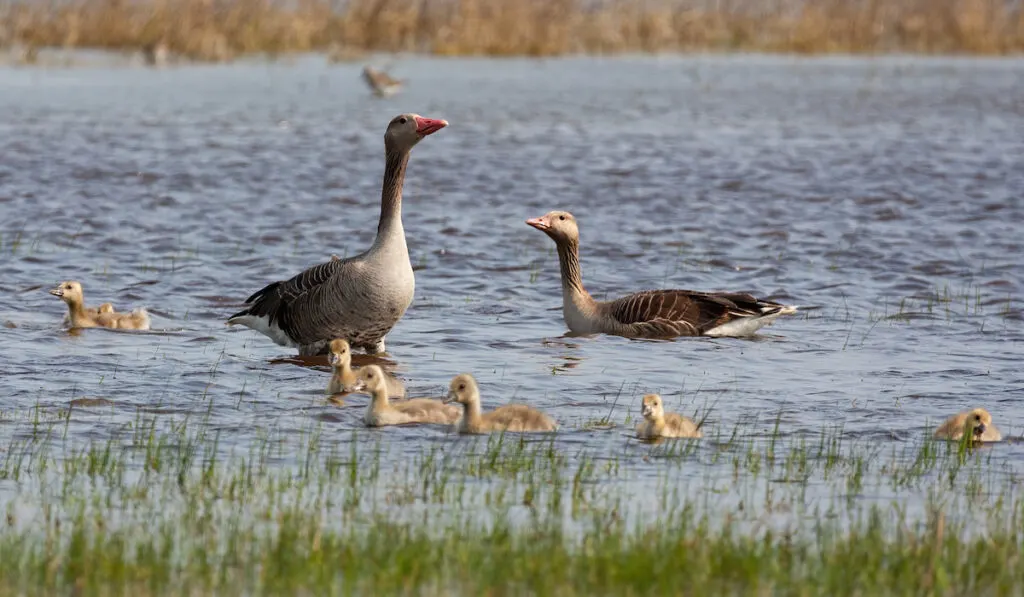
Geese are duck-like birds in the family of Anatidae. Geese are similar to ducks, but they have larger bodies, shorter beaks, and long necks. Just like ducks, they live around water bodies and love to swim.
32. Chinook Salmon (Oncorhynchus tshawytscha)

This beautiful salmon is named after the Chinookan people. It is the largest salmon in North America and is mostly used as food.
Chinook salmon has hot pink or peach scales below (around the stomach) and silver scales above.
33. Lake Trout (Salvelinus namaycush)
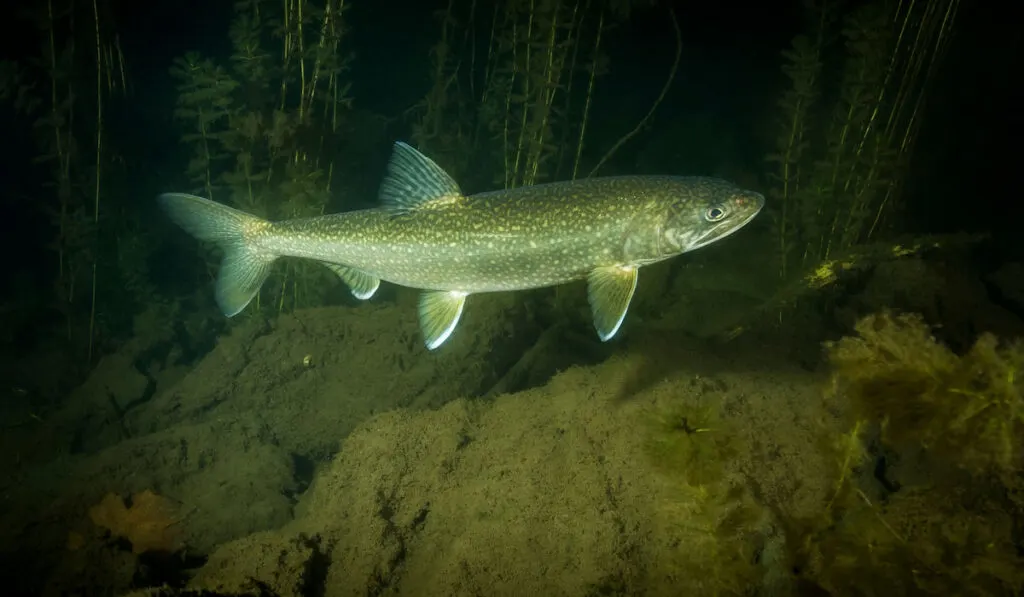
Lake trout are beautiful fish that live in lakes. They have forked caudal fins and eat other fish in the lake.
Other names for these fish include mackinaw, namaycush, togue, lake char, grey trout, and touladi.
34. Ring-Billed Gull (Larus delawarensis)
Ring-billed gulls are small or medium-sized gulls.
They have white bodies, ash-colored wings, black tails, and yellow bills and legs.
They live around water bodies such as lakes and enjoy eating fish and aquatic invertebrates.
35. Heron (Ardeidae)
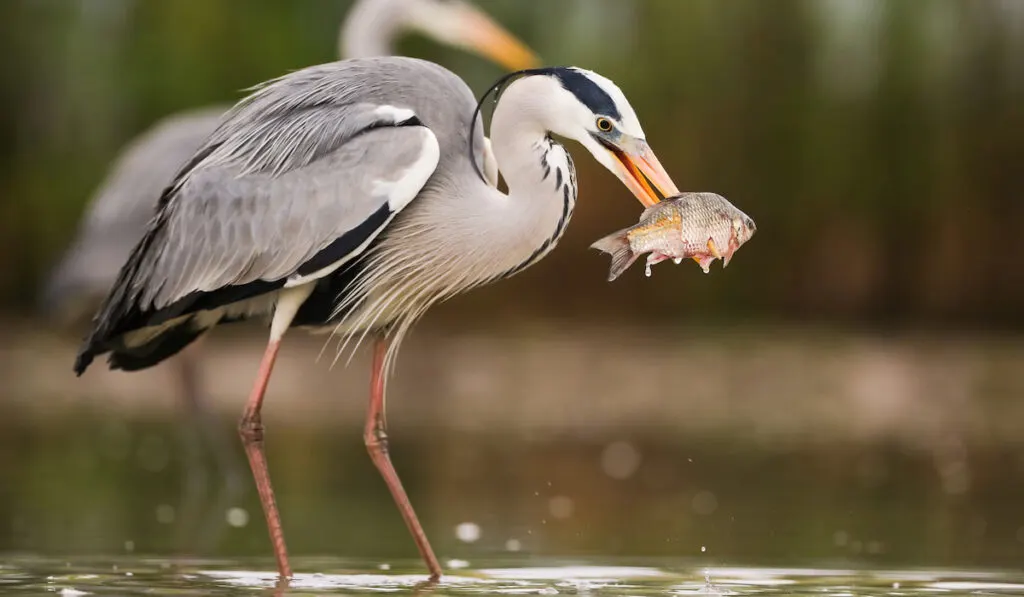
Herons are aquatic birds with long legs and long necks. They come in different colors but are usually white, brown, ash, or gray. They live around water bodies so that they can find fish to eat.
36. Newt (Pleurodelinae)
Newts are semi-aquatic amphibians that are closely related to salamanders. They hatch from their eggs in the water and then move out of the water when they are adults.
As larvae, they have gills. Just like other amphibians, however, their gills become lungs when they become adults.
37. Great Black-Backed Gull (Larus marinus)
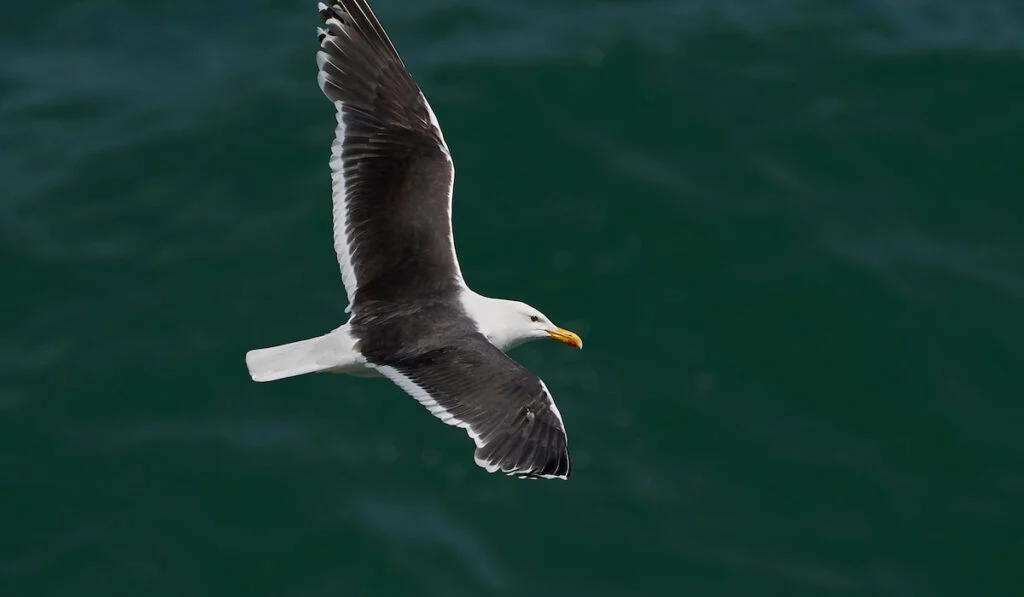
As their name suggests, these are gulls have black backs. Their body is white, and their beak, yellow. They are the largest gull.
While they fly with ease and can live wherever they want, these gulls prefer to live around water bodies such as lakes and rivers so that they can easily find food.
38. Clams (Bivalvia)
Clams are types of mollusks that live in their hinged shells. Their shell has two parts and opens and closes like a door whenever the clam wants it to.
Clams close their shells whenever they sense danger and then open them back when they feel safe. Clams are used to produce beautiful pearls that are used to make jewelry.
39. Lake Sturgeon (Acipenser fulvescens)
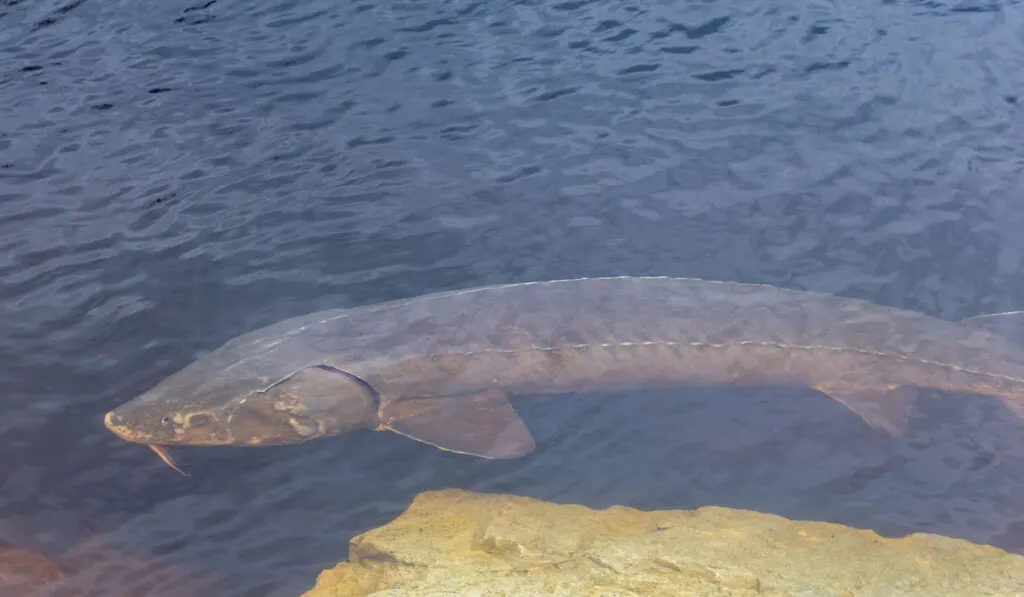
Lake sturgeons or rock sturgeons are very large fish that live in freshwater bodies in the temperate regions of North America. These fish live in the Great Lakes, and people enjoy eating them, especially when they are still raw.
Lake sturgeons are omnivores that eat other fish and large crustaceans.
Lake sturgeons can live for more than 100 years!
40. Salmon (Salmo salar)
Salmon are popular fish that spend part of their lifecycle in freshwater and other parts in salt water. This means that even though you may spot them in lakes, they will surely migrate to the ocean sooner or later.
Salmon hatch in lakes and other freshwater bodies before migrating to the sea.
When they are mature enough to reproduce, they migrate back to the lake where they will lay their eggs.
41. Alligator (Alligator spp.)

Alligators are large reptiles and essential animals in lakes and other water bodies. Alligators have thick scale-like skins and very sharp teeth that they use to catch and tear their prey.
Alligators are cold-blooded, so they rely on nature (the sun) to regulate their temperature. While they swim and live in lakes, they spend a large amount of the day lying on the shore so that they can become hot.
42. Leech (Hirudinea)
Leeches are parasitic worms found in so many water bodies, especially lakes and rivers.
Leeches cling to their host, sucking the blood from the host and only releasing themselves when they are full.
Leeches can kill fish and other animals in the water, especially if many leeches attack one fish at a time.
43. Freshwater Prawn (Macrobrachium spp.)
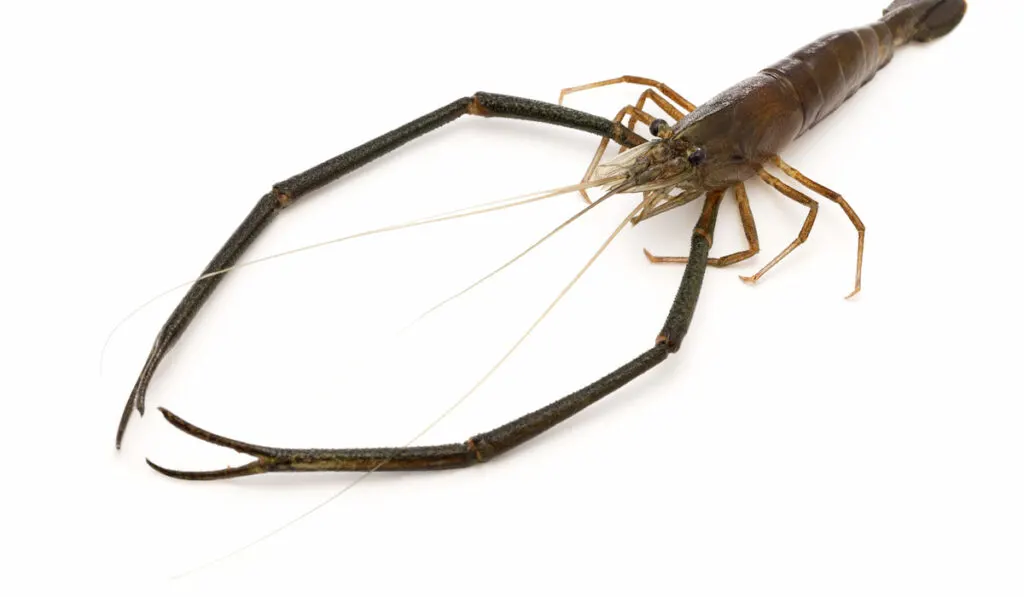
Prawns are insect-like animals known as crustaceans. They spend some parts of their lifecycle in salt water and then migrate to freshwater bodies such as lakes to lay their eggs.
Prawns can eat both phytoplankton and zooplankton, but they prefer a plant-like diet.
Prawns are eaten by almost every carnivorous fish that can find them. People also eat prawns.
44. Mayflies (Ephemeroptera)
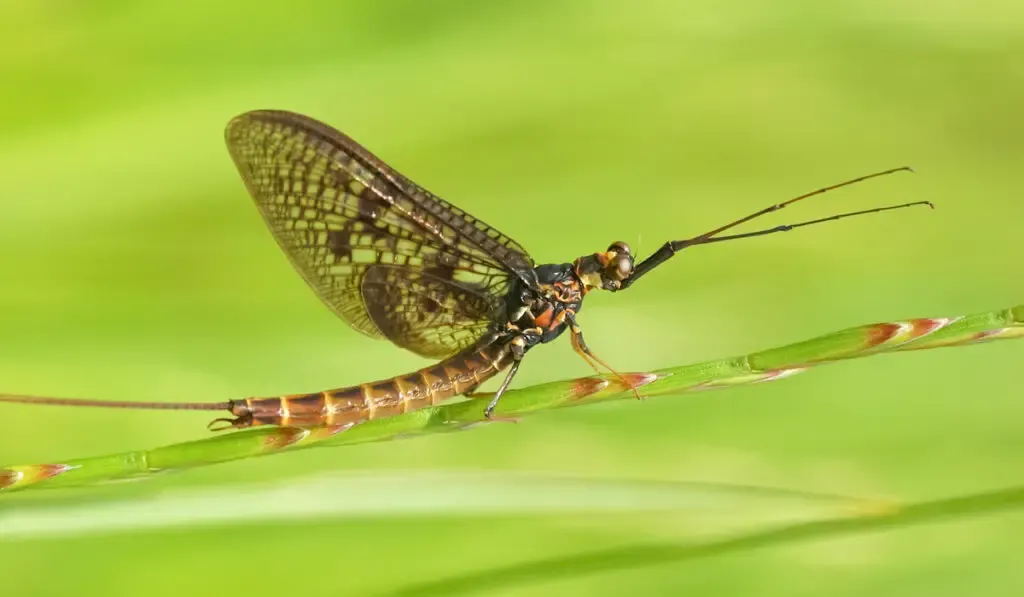
Mayflies are insects that resemble dragonflies. Unlike dragonflies, mayflies have short wings and two long appendages in their abdomen.
These insects are called mayflies because they emerge as adults when the mayflower is in bloom.
Just like dragonflies, mayflies have a very high rate of success when hunting their prey. While their larvae can live for more than a year, the adults only emerge and live for a day or so before they die.
45. Scaup (Aythya affinis)
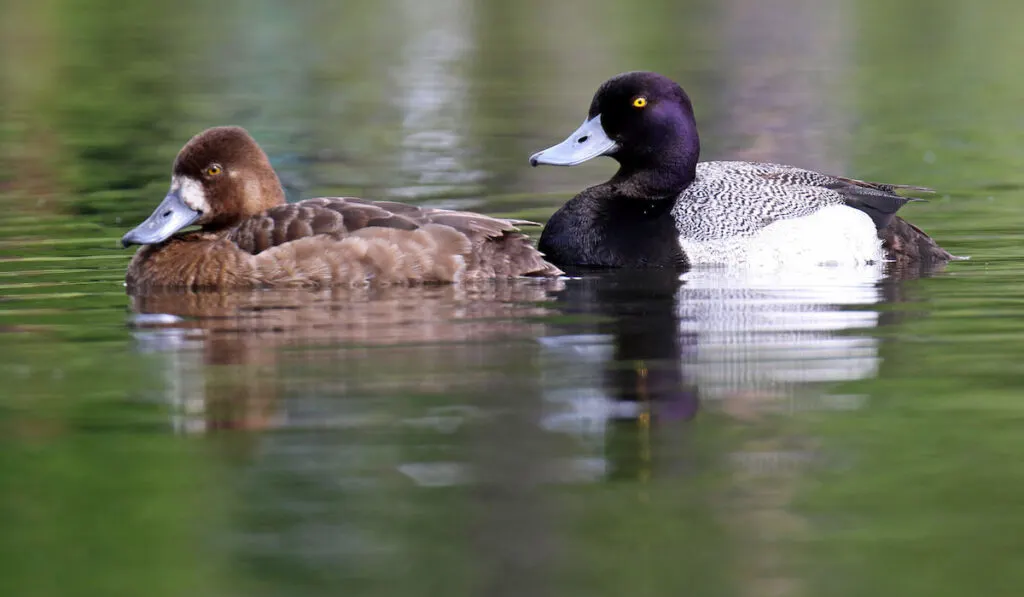
The scaup, which has other names such as broadbill or little bluebill, is a type of duck with a small blue bill. While it lives in North America, this species can fly and migrate as far as Central America.
When they are on land, they mostly perch around lakes where they can find fish and other types of food.
46. Crabs (Brachyura)

Crabs are crustaceans with hard shells that are found in so many types of water bodies in the world.
Many crabs are osmoconformers. This means that with their ability to adapt quickly to any amount of salt in the water, they can live easily in both salt and freshwaters.
Crabs eat plants as well as smaller animals in the water. When it’s time to lay eggs, some crab species dig holes outside the water and lay their eggs.
47. Eel (Anguilliformes)
Eels are slimy fish that are found in freshwaters such as lakes.
There are many types of eels, but the most common type is the electric eel.
Electric eels can produce currents that can shock their prey. They also use electricity to shock their predators so that they can escape.
Do not mess with eels.
48. Swan (Cygnus Spp.)

Swans are aquatic birds like geese and ducks.
Just like flamingoes, swans have long necks. However, swans are generally white and swim on the water with grace, while flamingoes prefer to walk.
Swans look for fish and other aquatic animals to eat. Just like other birds, they can walk, swim, and fly with ease.
When two swans are courting, they sometimes arrange their necks to form the shape of a heart.
49. Freshwater Snail (Gastropoda)

There are so many types of snails, but the ones that live in or around lakes are known as water snails. These snails usually have shells that help protect them from predators.
There are some types of snails that do not have shells. Snails eat whatever they can find as scavengers but are eaten by every carnivorous fish that can find them.
50. Mink (Neovison vison)
Minks are dark-brown or black mammals in the same family as otters and weasels.
They live most of their lives in or around water bodies, especially lakes, and have a strictly herbivorous diet. Minks eat plants, seeds, flowers, and fruits.
Minks can make great pets for you so long as you can provide a pool for them.
51. Manatees (Trichechus spp.)
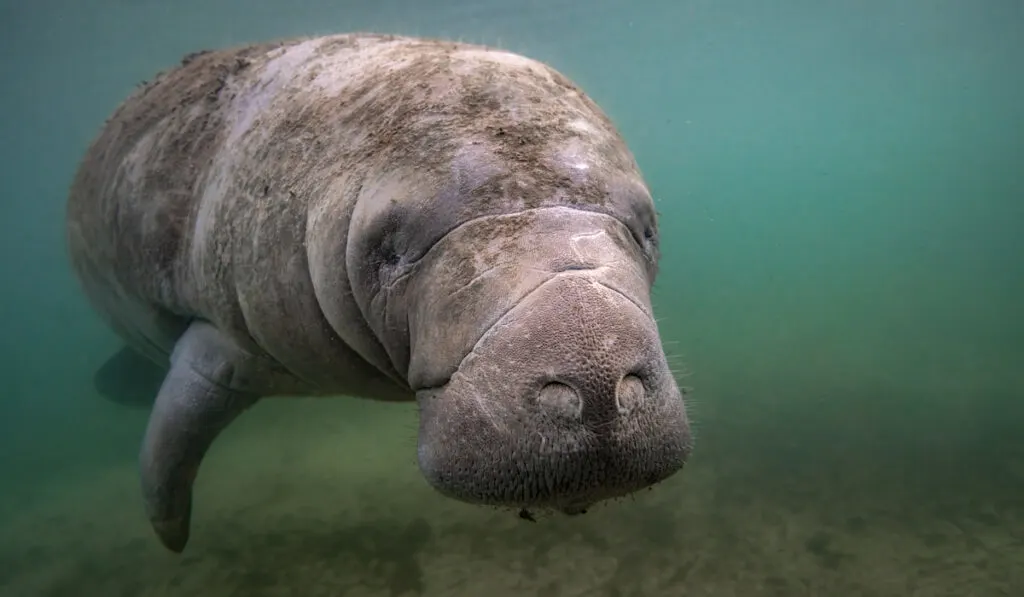
Sometimes called sea cows, manatees are strictly herbivorous mammals that are found in water bodies across the world. Some manatees live in lakes.
Manatees swim with grace, looking for grass and other types of plants that they can find in the water. Adult manatees can grow up to 9-10 feet long.
Conclusion
Animals that live in lakes are very beautiful and special in their own ways. Lakes are not complete without these animals, as they all have their roles to play. It does not matter if they are fish, mammals, or insects; there’s always a place for animals in lakes.
